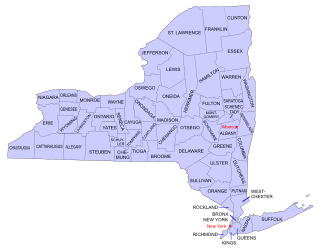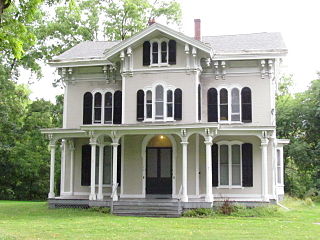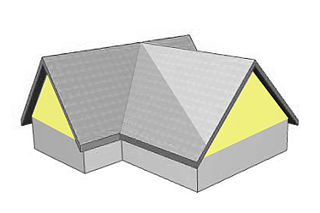
Buildings, sites, districts, and objects in New York listed on the National Register of Historic Places:

List of the National Register of Historic Places listings in Dutchess County, New York

The Clinton House is an 18th-century Georgian stone building in the city of Poughkeepsie, Dutchess County, New York, United States. It is a New York State Historic Site and has been listed in the National Register of Historic Places as a historic place of local significance since 1982. The house was named for George Clinton, who served as the first Governor of New York and fourth Vice-President of the United States. He was believed to have lived there after the American Revolutionary War, but it is now known that it was never his residence.

The Glebe House is an 18th-century Georgian brick building in Poughkeepsie, Dutchess County, New York, USA. It is listed in the National Register of Historic Places as a historic place of local significance since 1982.

Locust Grove is a National Historic Landmark estate located on US 9 in the Town of Poughkeepsie, New York. The 180-acre park-like estate includes homes, a carriage house, ice house, trails, a flower garden, and vegetable garden, and it overlooks the Hudson River from a bluff. The property includes a home designed by architect Alexander Jackson Davis for Samuel F. B. Morse, the inventor of the telegraph. An Italianate style mansion, it was completed in 1851.

Main Building is on the Vassar College campus in Poughkeepsie, New York. It was built by James Renwick, Jr. in the Second Empire style in 1861, the second building in the history of what was one of America's first women's colleges. It is one of the earliest, largest, and most important examples of Second Empire architecture in the United States and is a National Historic Landmark. At the time of its completion, the structure contained the most interior space of any building in the United States, and housed the entire college, including dormitories, libraries, classrooms, and dining halls. Currently, the first and second floors house campus administration while the remaining three house student rooms.

The Poughkeepsie Journal Building is the main office of that newspaper, in the city of Poughkeepsie, New York, United States. It is located at Civic Center Plaza, the north end of Market Street.

The Farmer's and Manufacturer's Bank building is located at the corner of Market and Cannon Streets in downtown Poughkeepsie, New York, United States, near the Bardavon and across from the Dutchess County Court House and Old Poughkeepsie YMCA. It is one of only two non-residential Greek Revival buildings remaining in the city.

The Hasbrouck House, also known as the Evelyn Samuels Memorial Building, is located on Market Street in downtown Poughkeepsie, New York, United States, next to the Amrita Club building. It was built in 1885 as the home of Frank Hasbrouck, a local judge and historian. The architect was Frederick Clarke Withers.

Gregory House, is a historic home located at 140 South Cherry Street in Poughkeepsie, Dutchess County, New York. It was built about 1869, is a 2 1⁄2-story, Second Empire-style dwelling. It features a bellcast mansard roof.

The building at 73 Mansion Street in Poughkeepsie, New York, United States, was first built around 1890 as a single-family residence. It is next to the city's post office and across from the offices of the Poughkeepsie Journal, at the corner with Balding Avenue.

The Niagara Engine House is located on North Hamilton Street in downtown Poughkeepsie, New York, United States. It is a brick building constructed in the early 20th century, the only extant fire house of the six engine companies that once protected the city.

Thompson House is an historic structure located in Poughkeepsie, New York. Built c. 1880, it was listed on the National Register of Historic Places on November 26, 1982. The private residence is considered to be in "excellent" condition.

Eastman Terrace is a historic rowhouse block located at Poughkeepsie, Dutchess County, New York. It was built in 1872 and consists of ten sections. The block is three stories high on a raised basement. It features a mansard roof with polychrome slate and an elaborate roofline with decorative stone parapets and iron cresting. The block was part of a larger plan to develop the Eastman Park section of the city.

Freer House is a historic home located at Poughkeepsie, Dutchess County, New York. It was built about 1728 and is a 1 1⁄2-story, four-bay-wide frame farmers cottage built of coursed fieldstone. It is the oldest extant structure in the City of Poughkeepsie.

Rombout House is a historic home located at Poughkeepsie, Dutchess County, New York. It was built about 1854 on land that had been part of the original British royal Rombout Patent of 1685 and is a 2 1⁄2-story, three-bay-wide, Hudson River Bracketed architectural style dwelling. It sits on a raised basement and features a central pavilion. It has been owned by Vassar College since 1915.

Dwight–Hooker Avenue Historic District is a national historic district located at Poughkeepsie, Dutchess County, New York. It includes 17 contributing residential buildings in the most architecturally significant, turn of the 20th century neighborhood in Poughkeepsie. Most of the houses were built between 1895 and 1915 and are in a variety of popular revival styles. They are mostly 2 1⁄2 to 3 1⁄2 stories in height.

Percival M. Lloyd was an American architect.
William J. Beardsley was a Poughkeepsie, New York-based architect.


























